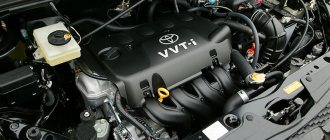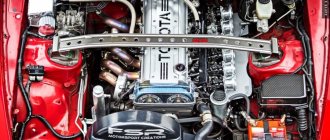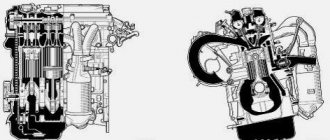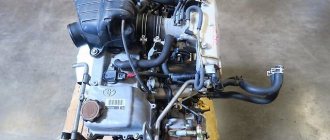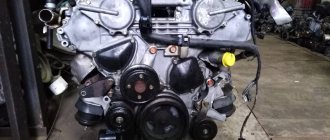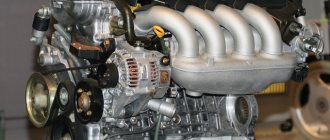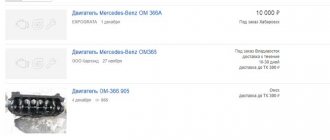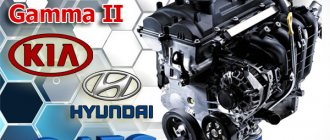Cars with internal combustion engine 1AZ FE
Since the start of production, the engine in question has been used in the following vehicles:
- From November 2003 to February 2009 on the second generation Toyota Avensis Verso, restyling, minivan.
- From August 2001 to September 2003 on the second generation Toyota Avensis Verso, minivan.
- In Russia from August 2011 to November 2014 on the eighth generation Toyota Camry, sedan, XV50 body.
- In Southeast Asia from July 2004 to September 2006 on the sixth generation Toyota Camry, restyling, sedan, XV30 body.
- From July 2001 to September 2006 on a sixth generation Toyota Camry, sedan, XV30 body.
- From October 2003 to January 2009 on the second generation Toyota Picnic, restyling, minivan, XM20 body.
- From March 2001 to September 2003 on a second generation Toyota Picnic, minivan, XM20 body.
- In Russia from September 2008 to April 2010 on the third generation Toyota RAV4, restyling, suv, XA30 body, Russia
- From November 2005 to December 2008 on a third generation Toyota RAV4, suv, XA30 body, Russia.
- From August 2003 to December 2005 on a second generation Toyota RAV4, restyling, suv, CA20 body, Russia.
- From August 2003 to December 2005 on a second generation Toyota RAV4, restyling, suv three doors, Russia.
- From May 2000 to August 2003 on a second generation Toyota RAV4, suv three doors, CA20 body, Russia.
- From May 2000 to August 2003 on a second generation Toyota RAV4, suv, CA20 body, Russia
- From November 2005 to December 2008 on the third generation Toyota RAV4, XA30 body, Europe.
- From August 2003 to December 2005 on the second generation Toyota RAV4, restyling, suv, three doors, XA20, Europe.
- From August 2003 to December 2005 on the second generation Toyota RAV4, restyling, suv, XA20, Europe.
- From May 2000 to August 2003 on a second generation Toyota RAV4, suv, three doors, XA20 body, Europe.
- From May 2000 to August 2003 on a second generation Toyota RAV4, suv, XA20 body, Europe.
- In America from May 2000 to July 2003 on the second generation Toyota RAV4, suv, CA20W body.
Description of the features of the 1AZ FE power unit
The power unit in question acquired registration on the assembly line in 2000. In a nutshell, it can be described as a universal power unit. It doesn't have too much power or high torque. The main feature of 1az fe is its high mileage with minimal construction costs. The new engine replaced the 3s fe, which had a large number of modifications; the 1az did not receive such variety over the years of production.
Features of the 1AZ FE cylinder block
The cylinder block of the power unit in question is made of durable aluminum alloy. Cast iron sleeves are filled inside. In the manufacture of BC, advanced technologies were used to reduce the cost of the product.
First, an aluminum profile was cast. In places where cast iron sleeves were poured, special notches were made to ensure the strength and integrity of the future part. The only drawback of this manufacturing method is that it is a one-time block. There is no possibility of a major overhaul for this engine. It is necessary to note the peculiarities of the arrangement of the cylinders. The axes of all cylinders are shifted towards the crankshaft. At the same time, the load on the walls of the cylinders and pistons is reduced, thereby ensuring maximum service life of the cylinder block.
Features of the cylinder head device
The BC head is made of durable aluminum. The valve cover is also made of aluminum alloy, to which magnesium has been added for strength. Inlet ports of the cylinder head, falling type. This internal combustion engine has transverse gas exchange manifolds and a tent combustion chamber. To prevent overheating of the head and the entire motor, there is a bypass channel under the exhaust gas channels for the circulation of coolant. The head has two camshafts and 16 valves, four for each cylinder.
Description of the structure and operation of the timing belt
The gas distribution mechanism 1AZ FE is made according to the classic DOHC scheme. This design features two overhead timing shafts and 16 valves. Four valves for each individual cylinder, two intake and two exhaust valves. There are shafts on different sides of the BC head.
One camshaft is designed to admit the combustible mixture. Intake occurs through a plastic intake manifold. By opening the two intake valves of each cylinder. The valves open due to the influence of the intake camshaft cams on them through the rocker arms.
Another camshaft is responsible for releasing exhaust gases through a welded steel manifold. The release of exhaust gases occurs due to the opening of two exhaust valves of each cylinder, and their opening is carried out due to the action of the cams of the exhaust camshaft through rocker arms and pushrods. Hydraulic compensators are not provided in the timing system of the engine in question. Therefore, manual adjustment of the thermal clearances in the valves is periodically required. To adjust the intake phase, a system that changes the valve timing is installed on the intake camshaft.
Features, purpose and operating principle of the VVTi system
At the end of the 90s of the last century, Toyota Corporation engineers created a technology that automatically controlled the phases of distribution of the combustible mixture. This VVTi system is a mechanical unit that changes the position of the intake valve timing shaft. The biggest change in relation to the drive sprocket is 60 degrees. A new system was intended to improve the technical data of the power unit, reduce fuel consumption and reduce emissions of harmful substances into the atmosphere.
The VVTi drive of the 1AZ FE internal combustion engine has the form of a rotor with small blades. Before starting the engine, the rotor corresponds to a late ignition, which ensures easy starting of the engine. After starting the internal combustion engine, oil begins to flow into the rotor from the engine oil system. The amount of engine lubricant supplied is controlled by a solenoid valve that controls the controller.
The position of the camshafts and the operation of the entire VVTi system are monitored by special sensors. They, in turn, transmit all the information to the controller, and he manages the effective operation of all power unit systems. The pressure of the flow of motor lubricant ensures a delay or advance in the phases of distribution of the combustible mixture. The result of the correct operation of the phase regulator is the well-functioning operation of the power unit.
Timing drive
The timing mechanism drive has a reliable chain design. However, if the timing chains jump or break, the engine bends the valve. But as for the 1AZ FE specifically, this engine doesn’t just bend the valves, it seriously destroys the cylinder head. The consequences of destruction, complete failure of the cylinder head, and the impossibility of repairing it. After such a problem, there is only one way out - purchasing and installing a new cylinder head.
Design features of the 1AZ FE ShPG engine
The piston bottom, to improve the working torque, has wedge displacers. The piston itself is made of light aluminum alloy and has a compact skirt with a polymer coating.
The connecting rods and connecting rod caps of the 1AZ FE engine are made using a new high-pressure sintering technology from steel powder material. The connecting rod cover is bolted to the connecting rod body up to the yield point. To reduce friction, the width of the liners was reduced. Yield strength, connecting rod bolt tightening 240EG45.
The five-support crankshaft is a forged product made of durable steel, with four connecting rod journals. The crankshaft has eight counterweights to ensure dynamic rotation of the crankshaft. The fillets of the main and connecting rod journals were strengthened by knurling a roller. There are air channels in the crankshaft bed.
Features of the lubrication system
The 1AZ lubrication system is forced. The internal combustion engine parts are lubricated under pressure and include a full-flow oil filter. To create pressure in the lubrication system of the engine in question, a gerotor-type oil pump is used. The pump is driven from the crankshaft by a chain transmission. To facilitate maintenance of the lubrication system, the oil filter is located at the bottom of the oil pan. The lubrication system includes a phase regulator. Which required the inclusion of a hydraulic valve and a hydraulic coupling to drive the camshaft.
The lubrication scheme is presented in the following order:
- Through the oil receiver with a strainer, the oil enters the oil pump;
- then through the editing valve and filter it enters the central oil line;
- from it, through the channels to the crankshaft journals and into the BC head, to lubricate the camshaft journals and parts of the VVTi system;
- to the oil jet for lubrication of the piston skirt and chain tensioner;
- Then the oil flows to the balance shaft and oil pan.
Features of throttle control
On the 1AZ FE power unit, the gas pedal is not mechanically connected to the throttle valve. The throttle valve has an intelligent control system (ETCS-i).
To change the position of the damper, a low-inertia electric DC motor is used, consuming minimal electrical energy.
In order to properly regulate the throttle opening, the ECU analyzes the pulse modulation of the direction and strength of the current that passes through the electric motor driving the throttle valve.
Features of the 1AZ FE fuel supply system
A closed fuel supply system is used to reduce the emission of gasoline vapors into the environment. Refusal to use backflow eliminated the possibility of heating the fuel in the fuel tank. This was made possible by combining the fuel pressure regulator and fuel filter into a single unit.
When supplying fuel, a twelve-hole atomizer is used. The conical shape of the sprayer promotes high-quality crushing of fuel; it has good performance qualities and a long service life.
Ignition system 1AZ FE
The engine in question uses a DIS ignition system with separate coils. This system improves the accuracy of ignition timing and reduces DC leakage at high voltages. And the absence of a distributor increases the overall reliability of the entire ignition system.
DIS is the most reliable ignition system, since each cylinder has an individual coil. Spark plugs for this system have iridium surfacing on the electrode.
Features of environmental equipment
To meet high European requirements for compliance with the amount of polluting particles in exhaust gases, the 1AZ FE internal combustion engine has a three-component neutralizer of harmful substances 01NEG38Y 5 installed in the exhaust system. To speed up the heating of the TWC and reduce the weight of the exhaust system, the manifold is made of stainless steel. The neutralizer is a container filled with ceramic filler, the cell density in it is optimized, and the wall thickness is reduced. The neutralizer significantly reduces the mass of harmful substances in the exhaust gases, which allows it to meet Euro 4 environmental requirements.
As you know, Japanese requirements for pollutants in exhaust gases are even stricter than in Europe. Therefore, on cars for the Japanese domestic market, an exhaust gas recirculation valve is installed. This system connects the exhaust and intake manifolds. When the oxygen content of the exhaust gases is high, the EGR redirects some of the exhaust gases back into the intake manifold, away from the throttle valve.
Disadvantages of the 1AZ-FE engine
- Cylinder block, cylinder head without the possibility of repair;
- Lack of repair dimensions for elements of the piston and crank group;
- The fuel pump is not designed for domestic gasoline;
- Coolant dripping from behind the cylinder block;
- Resonant vibration at low speeds;
- The engine jerks.
Disadvantages the 1AZ-FE engine
Cylinder block, cylinder head without the possibility of repair
The cylinder block and head do not structurally imply the possibility of repair. If the liners are worn out or if there are deviations in geometric dimensions due to wear, the block can be sold as scrap metal. The picture is exactly the same with the head. The design of the head is not designed for repair, i.e. It is impossible to replace or repair valves, as well as seats along with glasses for adjusting thermal clearances.
Lack of repair dimensions for piston and crank group elements
This drawback will force you to buy new parts and assembly units for the piston and crankshaft group, and this will entail high costs.
The fuel pump is not designed for domestic gasoline
The problem is the wear of the plunger pair when the engine runs on domestic gasoline and the subsequent entry of gasoline into the engine crankcase, reducing the viscosity of the engine oil. Further, all the rubbing elements of the engine will wear out rapidly (camshaft cams, liners, piston, etc.). Unfortunately, our gasolines do not contain lubricating additives, unlike foreign ones. A sign of wear on the plunger pairs is interruptions in the operation of the motor.
Resonant vibration at low speeds
This problem is not uncommon in engines and you may already be familiar with this phenomenon. On this engine, vibration appears at speeds of 500-600 rpm. It is impossible to eliminate it; this is a design flaw.
Engine jerks
Engine jerking is a sign that the throttle valve block in the intake cylinder, as well as the intake manifold with flaps, need to be cleaned of carbon deposits. Don't doubt it will help.
The engine, despite its shortcomings and weak points, is good, but... 1. Requires strict adherence to operating rules and timely maintenance. 2. As you already understand, the engine is beyond repair and is good until it reaches the mileage for repair, which is about 300 thousand km. Here you need to calculate correctly and not make a mistake. Otherwise, invest a lot of money in repairs. PS Dear owners of cars with a 1AZ-FE engine! Please write to us about your cases of any problems related to the engine.
Decoding the 1AZ FE engine markings
In 1987, a new coding formula for Japanese power units was adopted. Knowing the meaning of the symbols located in different places, you can obtain certain information about a specific power unit. This information is encrypted in advance in the name of the Japanese engine in question.
The general formula of the name looks like this: X XX XXX. In it, the number always comes first.
- In this case it costs 1. It means the generation of internal combustion engines of a specific line of engines.
- The next two characters are Latin capital letters. They designate the specific motor family to which the engine in question belongs. AZ is a family of engines, where A is the model line, and Z indicates the type of fuel used, gasoline.
- This is followed by three or two capital Latin letters. They indicate the features of the power unit and its design. The letter F means the use of a DOHS type gas distribution mechanism on the engine, two overhead camshafts and 16 valves for four cylinders.
- The final symbol E in the name indicates the presence of electronically controlled fuel injection on the engine.
If you put all the values together, the result is: a first-generation gasoline power unit of the AZ family, which has a DOHC type timing belt; the fuel injection of this engine is controlled electronically.
Modifications of the first generation AZ engine
The first generation of this family did not have a large number of modifications, there were only two:
- 1AZ FE is the base, main engine of the family, the compression ratio of the combustion chambers is 9.6:1 and 9.8:1, it depends on the settings of the ECU parameters. Engine power from 145 to 150 hp at 6000 rpm min. This model was produced from 2000 to 2012.
- 1AZ FSE(D4), engine identical to 1AZ FE, the difference between the modifications is the use of direct fuel injection. The compression ratio depends on the electronics settings of 9.8:1, 10.5:1 and 11:1. The power of this power unit is 150 - 155 hp, at 6000 rpm min.
Tuning and modification of the 1AZ-FE engine
The issue of refinement and increase in power practically does not arise until 150 thousand kilometers. But after this milestone the engine loses some power. Given its robust design, the power unit can be easily improved using both software methods and hardware tuning.
The main possibilities for increasing power are as follows:
- Chip tuning using software methods (Stage 1). You can increase the power of the unit to 165-170 hp without harm to the engine.
- Boring. You can bore the cylinder block, and the output will be a 2AZ engine with a 2.4-liter volume and significantly increased thrust. But the cost is unrealistically high.
- Supercharging The turbocharger kit from TRD, for example, is suitable for this engine. Of course, you will need an intercooler, new injectors, a thicker cylinder head gasket and other minor modifications. Engine potential – 200 hp. without changing the piston group.
Specifications
1AZ FE is a four-stroke, gasoline power unit, the four cylinders of which are placed in one row and has the following technical data:
- Produced by Shimoyama Plant and Kamigo Plant;
- serial production took place from 2000 to 2012;
- The BC and cylinder head are made of aluminum alloy;
- the exact volume of the 1AZ FE internal combustion engine is 1998 cubic centimeters;
- power of the motor in question depending on the ECU settings at 6000 rpm min., from 145 to 150 hp;
- peak torque at 4000 rpm, 190 Nm;
- the weight of this motor is 131 kg;
- power supply - injection, electronically controlled injection;
- combustion chamber compression ratio 9.6:1, 9.8:1 depending on electronic settings;
- DIS ignition, separate coil for each cylinder;
- the intake manifold is made of polymer materials, the exhaust manifold is made of steel using welding;
- timing system - DOHC, 16 valves, a phase regulator is installed on the intake shaft, an exhaust gas neutralizer is installed on the exhaust shaft;
- ICE cylinders operate in order 1, 3, 4, 2;
- the engine complies with European standards - Euro 4;
- the piston stroke length is equal to the diameter of the cylinders and is 86 mm, such internal combustion engines are called square, they are particularly reliable and durable;
- aluminum pistons, made by casting, skirts have a polymer coating for strength;
- the crankshaft is made of forged steel, has a polymer gear designed for balancing shafts;
- operating temperature 95C;
Technical specifications 1AZ FE 2.0 l/145 l. With.
The main tasks at the design stage of the 1AZ-FE internal combustion engine at the end of the 90s were:
- application of all existing developments in the engine;
- minimal volumes of combustion chambers, since this is the first engine in the series;
- reduction in weight and dimensions to improve the dynamic characteristics of heavy Toyota vehicles;
- it was necessary to increase the power slightly, with particular attention to increasing torque.
Non-rebuildable cylinder block
The option of casting the cylinder liner inside the block was used by the concern to reduce costs and improve quality. A side effect was that the service station overhaul became impossible, even with a serious machine tool base.
The entire family of Japanese AZ series engines is characterized by the impossibility of flashing controllers, so a feature of the 1AZ-FE inline gasoline engine is a complex upgrade.
The technical characteristics of 1AZ FE result in the following values:
| Manufacturer | Kamigo Plant, Shimoyama Plant |
| Engine brand | 1AZ FE |
| Years of production | 2000 – … |
| Volume | 1998 cm3 (2.0 l) |
| Power | 106.6 kW (145 hp) |
| Torque moment | 190 Nm (at 4000 rpm) |
| Weight | 131 kg |
| Compression ratio | 9,6 – 9,8 |
| Nutrition | injector |
| Motor type | in-line petrol |
| Ignition | DIS |
| Number of cylinders | 4 |
| Location of the first cylinder | TVE |
| Number of valves on each cylinder | 4 |
| Cylinder head material | aluminum alloy |
| Intake manifold | polymeric |
| An exhaust manifold | steel, welding |
| Camshaft | 2 pieces, overhead arrangement, DOHC V16 circuit, timing clutch and drive rotor on the intake shaft, drive gear on the exhaust shaft, |
| Cylinder block material | aluminum with cast iron sleeves |
| Cylinder diameter | 86 mm |
| Pistons | cast aluminum, polymer coated skirts |
| Crankshaft | forged steel with polymer gear for balancer shafts |
| Piston stroke | 86 mm |
| Fuel | AI-92/95 |
| Environmental standards | Euro 4 |
| Fuel consumption | highway – 7.3 l/100 km combined cycle 9.8 l/100 km city – 11.4 l/100 km |
| Oil consumption | within 1 l/1000 km |
| What kind of oil to pour into the engine by viscosity | 0W20, 5W20 |
| Which engine oil is best by manufacturer | Eurol Super Lite, Wolf Vitaltech Asia/US |
| Oil for 1AZ FE by composition | synthetics, semi-synthetics |
| Engine oil volume | 4.2 l |
| Operating temperature | 95° |
| ICE resource | declared 250,000 km actual 400,000 km |
| Adjustment of valves | pushers without washers |
| Cooling system | forced, antifreeze |
| Coolant volume | 7.1 l |
| water pump | Aisin WPT-129V |
| Spark plugs for 1AZ FE | Original IK20 90919-01210 |
| Spark plug gap | 1.1 mm |
| Valve train chain | roller, 3 configuration options T030K, T031K, T051B |
| Cylinder operating order | 1-3-4-2 |
| Air filter | Mann C2620 |
| Oil filter | Jakoparts J1312014, Fram PH4967, Filtron OP621 |
| Flywheel | lightweight, with a clutch diameter of 215 mm |
| Flywheel mounting bolts | M12x1.25 mm, length 26 mm |
| Valve stem seals | manufacturer Goetze |
| Compression | from 13 bar, difference in adjacent cylinders maximum 1 bar |
| XX speed | 750 – 800 min-1 |
| Tightening force of threaded connections | spark plug – 30 Nm flywheel – 130 Nm clutch bolt – 57 Nm intake manifold – 30 Nm cylinder head – 79 Nm + 90° |
The parameters of the only modification of the engine differ insignificantly.
Typical malfunctions of 1AZ FE and methods for their elimination
The engine in question has a number of inherent malfunctions:
Thread breakage on cylinder head studs
Very often on this engine, threads break on the cylinder head mounting studs. Additional washers and gaskets do not help the situation. There is a violation of the geometry of the entire structure, which is why antifreeze accumulates on the rear wall of the BC. The issue can be resolved by performing an expensive repair to replace the cylinder head stud. Otherwise, you will have to sell the block for non-ferrous scrap metal.
Vibration at idle
Engine vibration at idle speed is not a rare occurrence here. Vibrations occur due to unstable engine operation at idle. Cleaning the system responsible for supplying fuel will help solve the problem. If the measures taken do not help, then you need to clean the exhaust gas recirculation system. If all is in vain, all that remains is to clean the idle air valve and replace the engine support pads. But it happens that after carrying out all these measures, it is not possible to completely eliminate engine vibration at idle. But nothing can be done, slight vibration is one of the significant drawbacks of this power unit.
Intake manifold clogged
Sometimes the engine starts to jerk when the throttle is opened. This may be due to a dirty intake manifold; cleaning it usually resolves the problem. If it doesn’t help, the reason is a problem with the VVTi valve or oxygen sensor.
The revolutions begin to float
This problem is typical only for cars imported from Japan. It's all about the culprit of the malfunction, which is the EGR system. In Japan, environmental requirements are stricter than in European countries, so this exhaust gas recirculation system was installed in cars intended for the domestic Japanese market. But for European cars the EGR system was not used. If you happened to purchase a car intended for the domestic Japanese market, then the EGR system needs to be turned off and the electronics configured to work without this system.
Increased fuel consumption
Increased fuel consumption is typical for this engine model after a mileage of 200 thousand km. This is usually the consequence of using low-quality fuel. Replacing the injectors, as well as diagnosing and, if necessary, adjusting the ECU will help resolve the issue.
Advantages and disadvantages
The advantages of 1AZ-FE naturally aspirated engines are:
- low vibrations and noise;
- safety margin and acceptable power density;
- reduced weight and compact design;
- reduced fuel consumption and exhaust toxicity;
- high resource within 400,000 km.
On the other hand, boosting the engine is very difficult, almost impossible. When the timing chain breaks, the piston necessarily bends the valve. If the cylinders are worn out, it will not be possible to carry out major repairs either with your own hands or at a specialized service station, since the block is non-repairable. The weak points of the motor are:
- fuel pump - low resource on domestic fuel;
- intake manifold - plastic often does not withstand seasonal temperature changes;
- cylinder head attachment point to the block - the thread is pulled out or breaks off in the internal combustion engine until 2007.
Broken thread inside the block
Even in difficult operating conditions, engines with normal maintenance last twice as long as the resource declared by the manufacturer.
Operational maintenance 1AZ FE
The quality and service life of the power unit depends on correct and timely maintenance, therefore, in order for the engine to delight you with impeccable operation for a long time, it is necessary to carry out specific technical measures in a timely manner:
- The most common and very important procedure is changing the engine lubricant. It should be carried out simultaneously with the oil filter. The manufacturer recommends replacement after 10 thousand km. But here you need to take into account the presence of a phase regulator on the intake shaft on this motor. Which immediately makes the engine more demanding on the quality and lubricating properties of the oil. Therefore, it is better to reduce the oil and filter change period to 7.5 thousand km. Recommended types and brands of oil are indicated in the “Technical data” section;
- also after 10,000 km, the manufacturer recommends replacing the spark plugs;
- after 20 thousand km, the antifreeze loses its quality and needs to be replaced;
- due to the lack of hydraulic compensators on this internal combustion engine, after 30,000 km, there is a need to adjust the thermal clearances of the valves;
- according to the manufacturer’s recommendations, after 40 thousand km, you need to replace the battery and attachment belts;
- The exhaust gas purification system, in the form of a neutralizer, will begin to malfunction by 60 thousand km. It must be updated according to the manufacturer's recommendations.
To perform these works, expensive equipment and special devices are not required. All areas required for maintenance are easily accessible. And to carry out the above activities you do not need special technical knowledge. Therefore, you can do the work yourself, without involving expensive service station personnel.
According to many owners of a car with the 1AZ FE internal combustion engine, the task of achieving high power, optimal fuel consumption and low toxicity, set before Toyota engineers, was fully accomplished.
